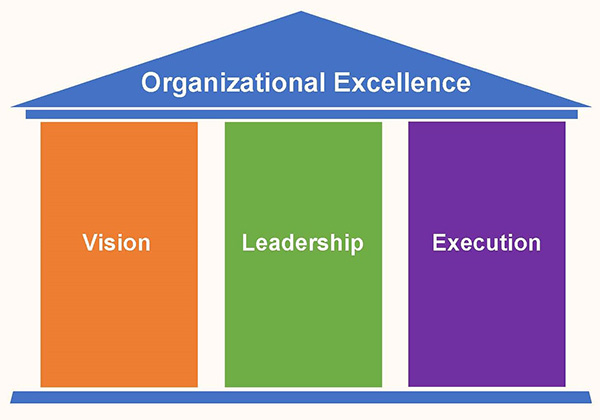The three pillars, or triad, of organizational excellence are vision, leadership, and execution, and are key to the success of any business.
By Vulchi Venkata Chandra Subramanya Kiran
The three quintessential pillars underpinning the success of any organization are vision, leadership, and execution. Collectively, these factors constitute a robust framework that enables organizations to excel, deliver consistent outcomes, and solidify their roles as industry leaders. A deficit in any pillar could jeopardize the stability and long-term viability of a business.

A cogent vision serves as an organizational compass, guiding decision-making processes and offering a sense of purpose that transcends the pursuit of profitability. Tim Cook of Apple encapsulated this idea succinctly when he said, “We focus on making the world’s best products and enriching people’s lives.”
Vision provides a purpose for the company toward achieving a common goal beyond making a profit. The company vision articulates what a company looks like once it achieves the success it seeks. It is the big-picture expression of what the organization hopes to become and accomplish, representing its contribution to customers, society, and the world at large. It is critical that employees at all levels buy into and share the vision. As such, a leader cannot push a vision that front-line employees do not share and relate to.
Businesses like Apple, Amazon, and Tesla have visions that demonstrate they are willing to invest in the future. Apple’s vision statement is “to make the best products on earth and to leave the world better than we found it.” Tesla’s vision is “to create the most compelling car company of the 21st century by driving the world’s transition to electric vehicles.” The vision of Amazon is “to be earth’s most customer-centric company; to build a place where people can come to find and discover anything they might want to buy online.” These visions demonstrate the organizations’ shared focus on sustainable growth rather than short-term gains.
A compelling vision, while inspiring, remains dormant without adept leadership to transform it from an abstract concept into a concrete action plan. Exceptional leaders grasp the paramount importance of communication and possess a remarkable ability to not just articulate but passionately advocate for the organization’s vision. They engage stakeholders, both within the organization and externally, crafting a shared sense of purpose that permeates all levels of the team.
Warren Buffet, in his praise of Apple, lauds it as “incredibly well run,” attributing this remarkable organizational efficacy to the astute stewardship of Tim Cook. Exceptional leaders, like Cook, are not merely figureheads; they are strategic visionaries, ever adapting to the evolving business landscape. They understand the irreplaceable value of customer-centricity, anchoring their strategies in the needs and desires of those they serve. In their hands, a vision becomes a transformative force that propels the organization toward unprecedented success.
Vision and leadership stand as fundamental prerequisites for the third pillar—execution. The best run companies in the business world, irrespective of their industry or operational models, have attained excellence through their skillful execution strategies. They share a resolute commitment to fundamental principles that form the bedrock of consistent execution, demonstrating a profound dedication to long-term sustainability and the cultivation of future potential, as opposed to fixating solely on immediate gains and reactive maneuvers.
These organizations present invaluable insights into achieving success through execution, applicable to businesses across the board. To realize enduring growth, deliver unparalleled value to their customers, and solidify their positions as industry frontrunners, companies can adopt the following principles:
While technology and market dynamics continue to evolve, the enduring principles of vision, leadership, and execution remain immutable pillars of organizational excellence. For companies to thrive in today’s complex business environment, it is imperative for leadership to align individual objectives with a well-articulated, organization-wide vision. Effective leaders encourage their employees to view execution from a new perspective. When a shared vision is clearly articulated throughout an organization, individual goals are aligned with the organizational vision, and there is accountability for performance at all levels to ensure the set goals are achieved. A disciplined focus on these core pillars will pave the way for sustainable growth and enduring success in the contemporary business landscape.

About the Author:
Vulchi Venkata Chandra Subramanya Kiran (CK) is a senior cloud solution architect and proven transformational leader with more than 20 years of technology experience. His background includes SAP development, enterprise architecture, and organizational IT infrastructures. CK is certified in TOGAF and Azure, with expertise spanning cloud architectures to data analytics. He is recognized for and excels in spearheading migrations to cloud solutions, change management, and business process architecture and reengineering.
Scott Ellyson, CEO of East West Manufacturing, brings decades of global manufacturing and supply chain leadership to the conversation. In this episode, he shares practical insights on scaling operations, navigating complexity, and building resilient manufacturing networks in an increasingly connected world.